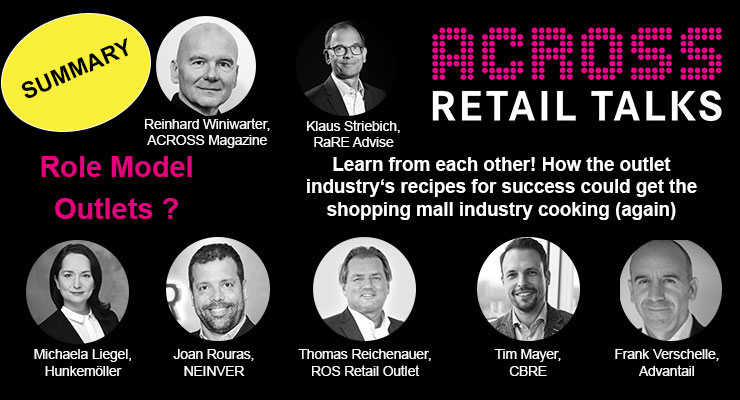The panel had a clear idea of what shopping malls should learn from the outlet center industry:
- Being closer to your tenants it will enable you to make quick decisions.
- Having a common (marketing) plan with your tenants.
- Overcoming your fear of turnover rates.
- Collecting and sharing your data.
Moderator Klaus Striebich, Managing Director of RaRE Advise and head of the ACROSS Advisory Board, led the discussion. He discussed with:
- Michaela Liegel, Head of Real Estate & Expansion Central & Eastern Europe Hunkemöller
- Joan Rouras, Leasing & Retail Director NEINVER
- Thomas Reichenauer, Co-Founder and MD of ROS Retail Outlet Shopping
- Tim Mayer, Head of Asset Management Retail Germany & Austria CBRE
- Frank Verschelle, Founder and CEO of Advantail
Development of outlets
Originally outlets were places for stock clearing, located out of town, and addressing a specific shopping behavior. Where are today’s outlets?
Thomas Reichenauer states: “Now we see all over Europe that outlets are coming closer to cities. They even might be an option for inner cities. The USP of outlets is excellent brands for good value. On the other hand, outlets are an experience and marketplace where you find most of the brands in one place in a convenient atmosphere.“
Michaela Liegel says: “Furthermore, there are ambitions in the market to pair outlets centers with regular full-price centers. We do not know in which direction this will go, but there are many ideas out there. What has changed is the shopping behavior. There are still deal hunters, but there is also an increasing number of visitors who combine the shopping experience with their holiday experience.“
Joan Rouras argues that speed in taking decisions and close cooperation with brand partners is most important: “The big difference to full-price models is the relationship with the brands and retailers on a day-to-day operation. This is part of the success formula. The closer we are with our partners the faster we can make decisions. Therefore we follow a much more sophisticated management technique.“
Frank Verschelle adds: “The big USP of outlets is the collaborative approach to retail. This is not only represented in the specific lease model but rather in the trust between management and retailers. Since management is always present and supporting the brands and shops, they are willing to share their information.” Outlet management and brands have a common marketing plan, staff training, and annual goals.
Tim Mayer agrees: “In shopping centers we historically focus on the rental level and rental income while the tenants of course want rent reduction. Therefore, we ended up in a competitive environment that we need to get rid of. We jointly have to take a look at retail KPIs such as footfall development and customers. I really admire several initiatives that can be seen in outlet venters like loyalty apps, where the management company and tenants work very closely together to understand their customers. And I think this is key because if you manage those KPIs correctly, then the financial KPIs become irrelevant. Because then turnover flows and you benefit from turnover rent. In my opinion, this is where full-price retail has to go, and outlet centers are probably 5 to 10 years ahead of us in understanding their customers.”
Outlet centers are sales machines
All this results in the fact that tenants are satisfied with outlet centers even though the average rental level and average extra charges might be higher than in shopping centers as Klaus Striebich mentions. Most outlet centers in Europe are fully leased, and a lot of extensions are happening.
Liegel as a representative of a retail company explains: “Outlet stores are usually highly profitable despite the comparatively high costs, restrictions, and fees. In the end, they are very professional, well-managed, fine-tuned sales machines, which on top do a lot for our brand awareness as a retailer. We also see where these fees are going. In shopping centers, I do not know what they do with the promotion fee. What’s more, nearly every contact person in the outlet industry has a retail mindset instead of a real estate mindset. They speak retail and not real estate. And this is the main difference for me as a retailer.”
Verschelle agrees: “We speak the same language. When you operate an outlet, retailers talk to retailers. Our professions may be operators, asset managers, or property managers but we only hire people with retail backgrounds. Otherwise, they cannot talk to retailers and understand what they need and how they work.”
The mindset needs to change
The panel agrees that rent is more or less the consequence for the landlord. But sales are generated in the shops. Consumers are going to the shops they like and spent their money there. So, the consumers should be the focus of the brand, and therefore the tenant the focus of the management. “It all starts with somebody buying goods in our stores”, argues Liegel.
Mayer, as a representative of the full-price business, states: “The mindset for the complete structure of investments needs to change. One of the main challenges is that turnover rent is seen as a very high risk. Therefore, investors feel insecure about retail assets. It is important that investors learn that turnover rents can work for all parties. We must communicate much more to the outside world what the needs of tenants, operators, and investors are to focus on retail in the long term. There are already retailers in full-price retail that only come into a center when you give them turnover rent. We all need to be way more flexible.”
However, not only the mindset of investors needs to change, but also steering and managing retail real estate assets must take a different approach. Former “finance KPIs” will be replaced by “retail KPIs” (when we focus on footfall, conversion rates, and basket sizes, the need for sales per sq m or even OCR – occupancy cost rates – are obsolete). Maybe the future is a “CPI” – Customer Performance Index, which could make everyone happy: customers, retailers, and investors… The solution is to focus on customers from every angle, from the very beginning.
We need more data
The biggest challenge in retail is attracting visitors and turning these visitors into customers. Therefore, data is crucial. Liegel states: “We need to improve the situation in shopping centers substantially. We need more data, and we also need more responsibility for shopping center managers. I do not see any sharing or exchange of data. How many visitors do they have? Where do we lose them? There is no analysis in this part and this is very disappointing, especially for a very technology-data-driven retailer.”
Outlet technology trends
Loyalty programs are one thing outlets use to collect data. Reichenauer explains the technology trends he is currently observing: “Loyalty programs are very easy to evaluate. Furthermore, they are bringing customers back with higher purchase power. Second thing, I think the marketing budget of the centers is shifting dramatically into digital and social media. The third thing is, again, customer experience. Our main goal is to bring people to the center, no matter if they come for click-and-collect or physical shopping. All activities, all experiences with all the programs, must create a kind of a wow effect, so people come to us.“
You can watch the uncut version of the latest ACROSS Retail Talks here:
We have more exciting discussions in our pipeline so follow us on social media to never miss the next ACROSS Retail Talks!






